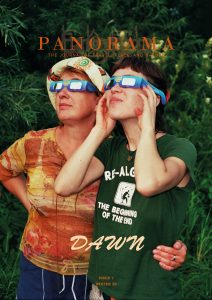An old woman perches atop a fifth-storey window. Her elbows rest on the wooden frame, once painted—now chipping, the remnants of burgundy flaking off more and more each day. Her hands reach for dried laundry that flutters on the line just outside the window. The creases in her forehead, her cheeks, her neck, the bags under eyes, indicate life has been tough; it’s felt like a battle, but she’s a survivor. She’s overcome the tumultuous years—of Salazar’s dictatorship, of financial crises, of exhaustion from years of trekking up and down steep cobblestones—to peering outside the third most peaceful country in the world. Blue and green tiles called azulejos pattern the building in intricate, geometric designs—some circular, others diamond-like—but a few are missing, leaving holes on the exterior. There’s no rush to fix them; imperfections in this city add character and patina, and locals take pride in them. This decorative art is Portugal’s ancient form of air conditioning, as the clay tiles, glazed in blue colours, best reflect the sun.
The woman fumbles with a clothes pin, accidentally releasing a pair of faded white underwear, which casually folds in the breeze to the cobblestone street below. Passersby don’t pay much notice; stray articles are often captured by the wind as old ladies are always doing laundry, keeping an eye on the happenings of life below, scoffing and chatting with their window neighbours across the way. Who needs security cameras when you have old ladies doing laundry keeping watch over the street?
A violinist competes with a cellist on opposite sides of the street, a hat on one side and an open instrument case on the other, both containing a few tossed coins from listeners shuffling past. They don’t seem upset playing in close proximity; their purpose is not to outperform but to help unite the city life into harmony. Further down the street a young woman wearing a pair of high wedges despite the cobblestones struts towards an outdoor quiosque, her flower-patterned dress flowing in the wind. She orders an amendoa amarga, a traditional Portuguese lemony almond liqueur, and sits down on a bench with a book. The smooth, melancholic sounds of the string instruments create the perfect ambiance to become lost within the pages, invisible amidst the crowd.
A rumbling sound erupts through grates in the street. The subsequent gust ruffles a tourist’s skirt as she crosses above it. Quickening vibrations on the cobblestones signal the next arrival at Baixa Chiado, the metro stop where the green and blue lines intersect. As the underground train screeches to a halt, a flood of people race up the stairs and blend into the city’s happenings. Some move with purpose while others stop at the top, mesmerized by the step back in time, with the centuries-old architecture growing more handsome with age, and the yellow 28 tram weaving by on the rusty tracks.
Others pause at the Fernando Pessoa statue, situated to the right of the metro exit. They crave a photoshoot with Portugal’s most famous writer. Perhaps some actually know who he is, but many simply fall into line, desiring a photo with the bronze man wearing a wide-brim hat and a bow tie. Some sit next to Pessoa, pretending to write alongside him; others kiss his cheek, leaving it shiny. It’s so unlike Pessoa’s character, to be in the spotlight when he’d rather be observing from the shadows.
Next to the Pessoa statue is Café A Brasileira, the staple establishment where Pessoa used to sit and record his musings, often bringing the ideas inspired by passersby into his storyline—his last name meaning ‘person’ after all. A waiter approaches a couple sitting under an umbrella near the street, an adjacent heater turned up to keep them warm; in the spring, it is replaced with a mist machine humming overhead to cool off the patrons. Lisboa is a city meant to be experienced outdoors. He asks the woman if she would like more coffee while pouring her husband another glass of vinho verde. It is early afternoon, but time has no place here, so it’s always appropriate for any type of beverage.
Smoke and steam permeate the air with a sweet, nutty aroma. Customers at the café and people walking by push their noses into the air. A vendor down the street sells castanhas, a Portuguese tradition similar to roasted chestnuts. This warm, seasonal treat is sold around town from the start of autumn through the end of the holiday season. When the stream from the latest batch settles, an adjacent cherry stand reveals itself, locals and tourists circling for warm and juicy treats. Some travel up and down the cobblestones nibbling on their delights while listening to the serenades of the violinist and cellist; others venture inside a pastelaria. Trays and trays of Pasteis de Nata glisten behind the transparent case, enticing customers to bite into these rich custard tarts. A container of cinnamon rests atop the counter for those wanting to garnish their treat with a sprinkle of spice.
A sprawling shopping mall called Armazéns do Chiado marks the end of the street. It’s a juxtaposition of modern architecture alongside worn cobblestones. Lisbon has mostly preserved its historic architecture, but this mall is one of the few examples of the city trying to keep up with the times. Much of Lisbon’s architecture has Moorish and Gothic roots, and these influences can still be seen in many buildings at their cores. However, after the Great Lisbon Earthquake of 1755, architecture in Portugal became what is called Pombaline Style—a mix of Baroque and Neoclassicism. Buildings were made entirely outside of the city and brought in, and they were only assembled after a stable base was constructed. They were much larger and more spacious, and their designs have a modern European influence.
If you walk from the metro exit toward the entrance, you will pass a BPI bank, clothing boutiques and a line of cafés. Halfway down on the right is a side street lined with tables of books. This literary market, an extension of Livraria Bertrand called Feira de Alfarrabistas, signifies that it is Monday. In the summer, it is also open on Saturdays. It is one of the oldest outdoor bookstores in the world. There are books in Portuguese and English and French and Spanish; some old and some new; some for only one euro. There are magazines and photo albums and history books and romance novels. And there is always a large selection written by Fernando Pessoa. Many people veer onto this street, mesmerized by hundreds of books lining the cobblestones as far as one can see.
Back on the main artery of Rua Garrett, a couple rests on the sidewalk with their two dogs. The damp piece of cardboard asks for help in Portuguese with ‘God Bless’ at the bottom. A man, perhaps their friend, stands in the street tossing flaming batons; a hat near his feet welcomes coins from strangers watching the show. Across the street, two gypsies sit on a tapestry decorating strings with ornate beads and patterns; between them is a case of earrings and other jewellery. Many locals would rather they move somewhere else—gypsies are a touchy subject here. Under Salazar’s dictatorship, gypsies were only allowed to remain 48 hours in a city before moving onward, but after he was overthrown, the government took extra properties from rightful owners and used them to rehabilitate the gypsies. Since the government still supports the gypsies, most do not have jobs other than panhandling, and they have made little attempt in the last 40 years to acclimate to Portuguese culture, which frustrates some native Portuguese. Regardless, every walk of life seems to coexist peacefully.
A man adorned in gold paint holds out his left hand, balancing on the top of a pole that somehow effortlessly supports his entire body weight; he moves his feet back and forth like he is running, and tourists pause to take photos of this gravity-defying act. They stop to stare and locals bump into their backs, muttering obscenities: “Ciganada” (“Gypsy”) and “Era fazê-lose todos ir num barco sem fundo direito ao Pacífico” (“Go back to the bottom of the ocean”). Further down the way, a woman holding a parasol covered in white paint is so realistic that when still, she appears to be simply a statue.
At the end of the street, inside the entrance of Armazéns do Chiado, there’s a flower shop and a gelateria. Many patrons exit with something consumable—a cone topped with flavors such as honey and pine nut or basil and lime—or a pot holding colourful fragrant plants. The gelato sometimes ends up adding colour to the otherwise grey cobblestones, especially in the hands of an excited child who ordered one-too-many scoops of pistachio. Some people continue their shopping at the travelling Fado cart, which sell the sounds of melancholic Portuguese music as it rolls along, enticing patrons with cups of hot mulled wine.
In the corner, a street artist brushes adhesive on the back of some parchment, gluing a sketch she created along a wall covered with various graffiti: posters, signatures, political quotes, realist scenery, abstract designs in erratic neon colours. She pulls out a can of blue spray paint, stamping her name to the collective mural. Most people respect street art in Lisbon, although sometimes art is removed or covered up simply for the sake of other art layered on top of it. Many people from the older generation don’t approve. The elderly woman in the window doing her laundry jams her finger down in the direction of the artist, shouting Para! Para!—Stop! Stop! She prefers her building to remain as it was, with the original azulejo tiles, even if dozens have fallen off. To the old woman, graffiti is damaging her building; but to the artist, Lisboa is a canvas.
The artist packs up her materials and heads over to Café A Brasileira where she sits and orders an espresso. She unzips her purse and pulls out a cigarette, lighting it as she inhales. The waiter brings her tiny cup and she swallows the espresso in one sip, without sugar. She props her feet on the chair next to her, inhaling another drag and exhaling it out into the city in front of her. Lisbon: an ashtray, albeit a beautiful one. The yellow 28 tram arrives again, unloading and reloading, and the Pessoa statue watches as it departs, history continuing to traverse down the tracks.











